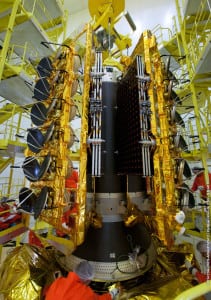Solutions Emerge to Tackling Latency
[Via Satellite 11-09-2015] Several companies are putting forth new approaches to handling latency in networks that could change the way communications are managed in the oilfield. Latency, known in satellite as the time it takes for a signal to travel from Earth to a satellite and back, has a minimum one-way speed of 242 milliseconds to Geostationary Earth Orbit (GEO). Additional steps and processes such as encryption can increase latency even more, sometimes to the point where services are not as effective or rendered unusable.
To handle this, companies are designing new approaches that can streamline the amount of time to send and receive data packets and reduce packet loss. Startup company Code On Technologies is commercializing Random Linear Network Coding (RLNC) as a means to expedite telecommunications.
Laila Partridge, managing director of Code On Technologies, said during OilComm’s “How to Work with Latency When you Must (and Avoid Latency When you Can)” panel that RLNC works differently by not requiring packets to arrive in the proper order. Typically, if packets in a data stream do not arrive in order, you get packet loss, which requires resending and creates latency.
“When they do not arrive sequentially, you have to throw them away,” she said.
On Code Technologies use linear algebra to have a mathematical representation of all the data, and by using randomly generated coefficients, eliminates this complexity.
“The most important piece is the fact that any mixture will do. What that means is we now don’t care about the packet arrivals, in fact we don’t care which packet arrives. We just take the first packet and start filling in that linear matrix, which starts solving as it flies by. We don’t have to wait for a whole set of packets to arrive, we just start solving as soon as you get the first one,” she explained. “The result is we have stateless communications. You do not need to track state.”
Partridge added that this opens up more possibilities, such as better multi-path communications, that can use both satellite and LTE. This also boosts redundancy, and inherently increases cybersecurity, she said.
RLNC has benefits for optimizing throughput as well, according to Partridge. “If you have a capacity issue on one [beam] you can just hop to another … or send them down two beams and combine them to get it faster. There are lot of ways to utilize multipath in a satellite world,” she said.
On Code Technologies has conducted tests with satellites and other telecom networks. Partridge said the company is in the early stages of commercializing RLNC, but is seeing positive signs. Through these implementations, On Code Technologies has seen a four-fold improvement in throughput, she said.
File Catalyst is another company making strides in addressing latency. John Tkaczewski president and co-founder of File Catalyst, said packet loss of less than 1 percent can become a major problem. FileCatalyst has done a lot of work with Transmission Control Protocol (TCP), which has been around since the 1970s, to improve communications.
O3b Networks, a growing satellite operator with a fleet of 12 Ka-band High Throughput Satellites (HTS), is taking a fundamentally different approach. The operator’s satellites are in Medium Earth Orbit (MEO), 8,062 kilometers above the Earth. From this vantage point, the company offers services with latency of approximately 150 milliseconds. Dennis Schumey, senior sales engineer at O3b Networks, said the company’s fleet of satellites is able to overcome challenges with latency, making applications such as Enterprise Resource Planning (ERP) feasible over satellite.
“In a world where people are increasingly reliant on social media, these are things that are really limited in an offshore environment because when you have a very expensive satellite solution and high latency, you are basically only using it for critical applications. You don’t want to waste any throughput on nice to haves. With a system like O3b on board, all these things become possible,” he said.
O3b’s satellite covers 45 degrees north and south of the equator, and can do some coverage up to 62 degrees in special cases.
“Digital oilfield concepts have being well established over the last 15 years and everybody is looking to squeeze more efficiency out of their operations,” said Schumey, adding that deep-water rigs typically rely on geostationary C-band and sometimes Ku-band satellites.
Schumey said O3b satellites can boost cybersecurity through penetration testing, and can improve the efficiency of inspections by eliminating the need for multiple inspections. This is because with real time connectivity, interactions between onshore and offshore personnel are accelerated, and findings can be addressed more readily. He added that remote connectivity through O3b can also help companies centrally locate skilled personnel in order to save money.
“There are a lot of challenges to having a constellation in MEO, but the benefits far outweigh it,” he said.
